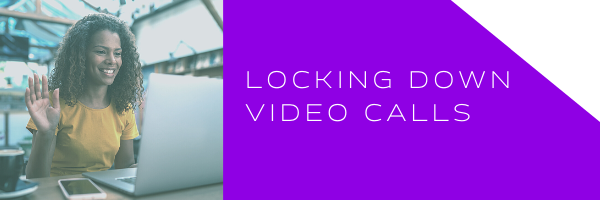
It’s October and we’re still working from home – and given current government restrictions and local lockdowns, it looks like that’s a situation which won’t be changing anytime soon, as such it’s imperative that we ensure our home-working practices and processes are secure.
Full Disclosure: In a perfect world, your security should be perfect too but we get it, March 2020 was a scramble for thousands of businesses to get things like video conferencing and calling in place, as quickly as possible. Here are our top tips for keeping video calls secure every time.
It’s all in the settings, check them!
We know you don’t do this, they’re the boring bit in the background – you just want to get on with the meeting/call – we know. But they are the most important thing you can do to protect yourself when using video calling platforms, your I.T department or provider (if you have one) should be able to provide these for you but if not here are some key things you should be looking for and doing:
- Make sure encryption is standard. E2E are the words you’re looking for to protect you. Tools like Microsoft Teams offers a highly secure solution which supports multi-factor authentication, data encryption and meets dozens of national, regional and industry-specific security/privacy compliance regulations.
- Look for security options that are not enabled by default – they’ll usually be a tick box in settings, enable them.
- Inspect your ‘User Profile’ what information is contained there? is there anything there which rings alarm bells?
- Look at what the app is ‘giving permissions to’ and turn it off.
- Turn off any third party sharing, advertising and anything that allows strangers to contact you via the platform
On The Call
Once you’re confident you’ve got things ‘locked down’ within your profile, you’ll need to think about the set up of your calls or meetings, and yep there’s a whole other set of ‘settings’ there too, here’s our advice for getting this right:
- Require passwords and authentication for ALL meetings.
- If you’re the host always join first and use the ‘waiting room’ feature to ensure you’re only admitting the people who should be on the call.
- Once things are underway, lock the call. You can allow late joiners at your discretion but don’t let it happen automatically.
- Control the chat: Don’t allow lots of files and links to be added in the chat. If it’s really important it can be sent in a follow-up email. You never know what’s in those files or links.
- Do not allow recording of the call for anyone other than yourself.
- Ensure everyone introduces themselves and you are aware of where people are on the call – if Bob is doing the team stand up in Starbucks that’s probably not ideal…
And finally, consider spending a bit more…
Over the past few months, businesses have had to invest in platforms and new tools to ensure ‘business as usual’ can continue, this coupled with unpredictable cash flow and general pandemic pressure can mean further investment in I.T isn’t always at the top of the agenda, but if your business is operating remotely with a heavy reliance on video calling platforms it really is worth considering some of the business, professional or enterprise solutions in the market.
Struggling with Security? We can help! Get in touch for an informal chat today!
